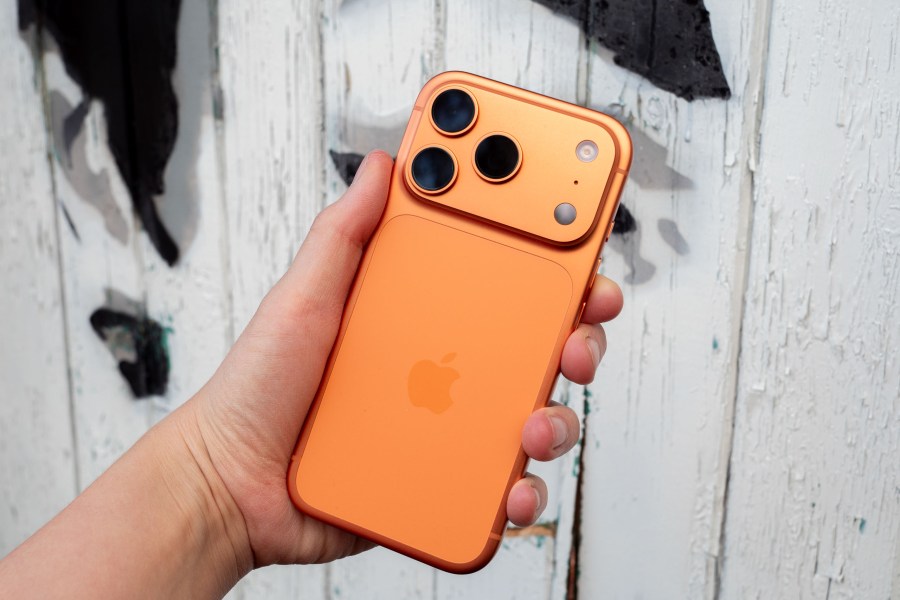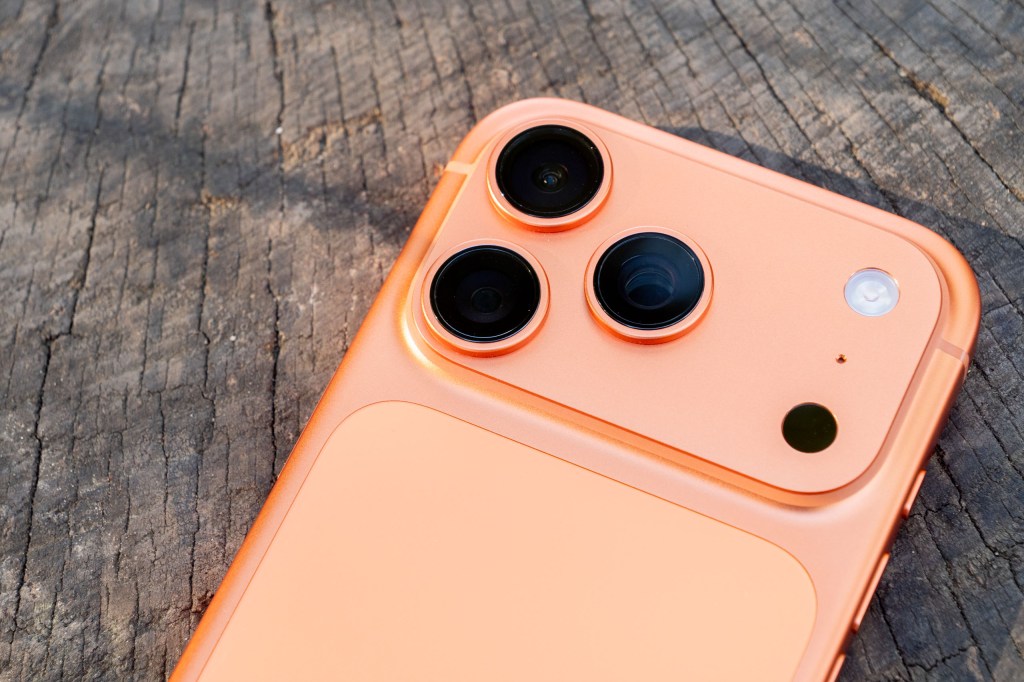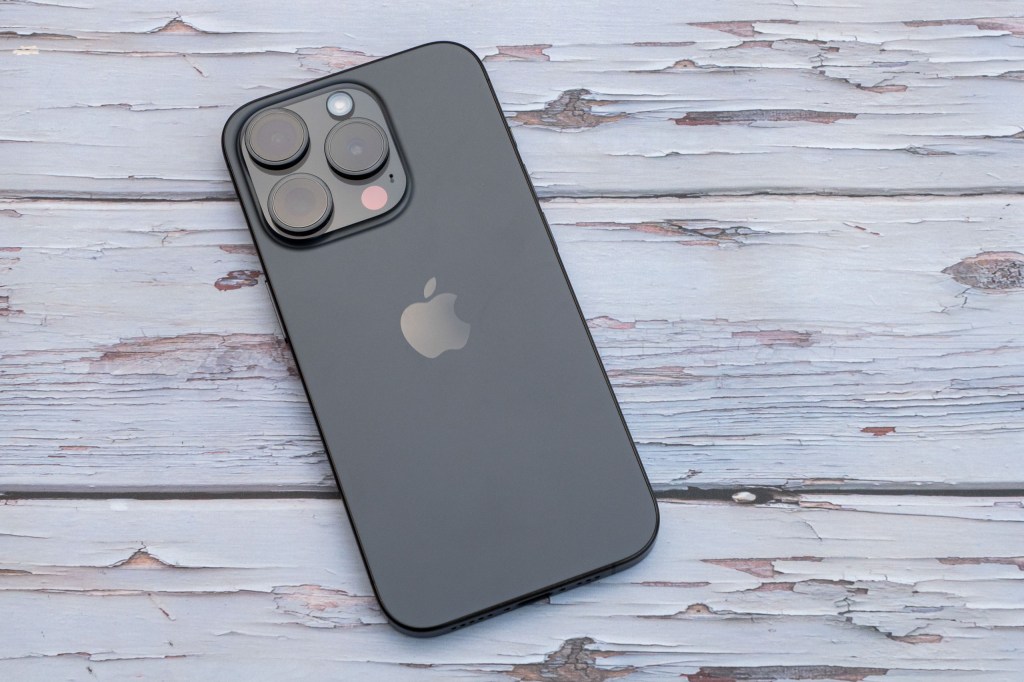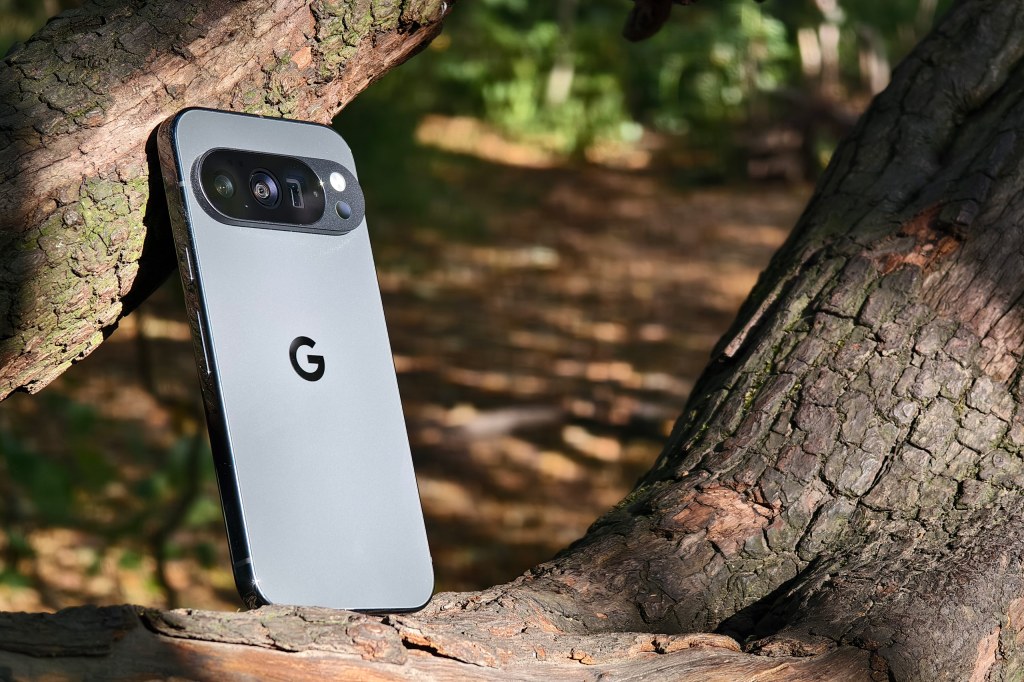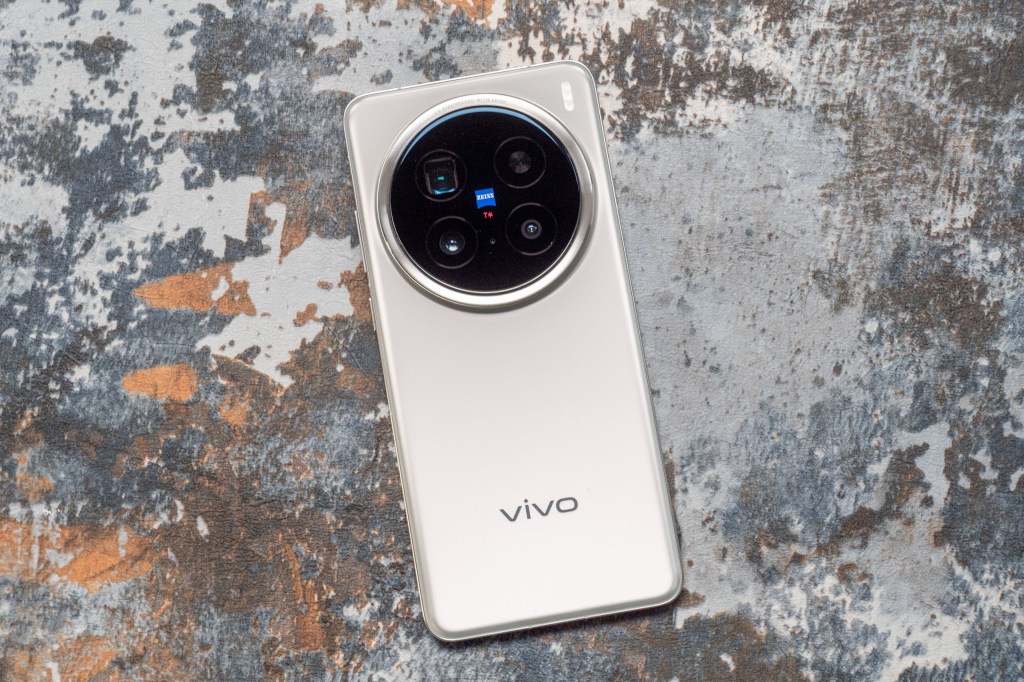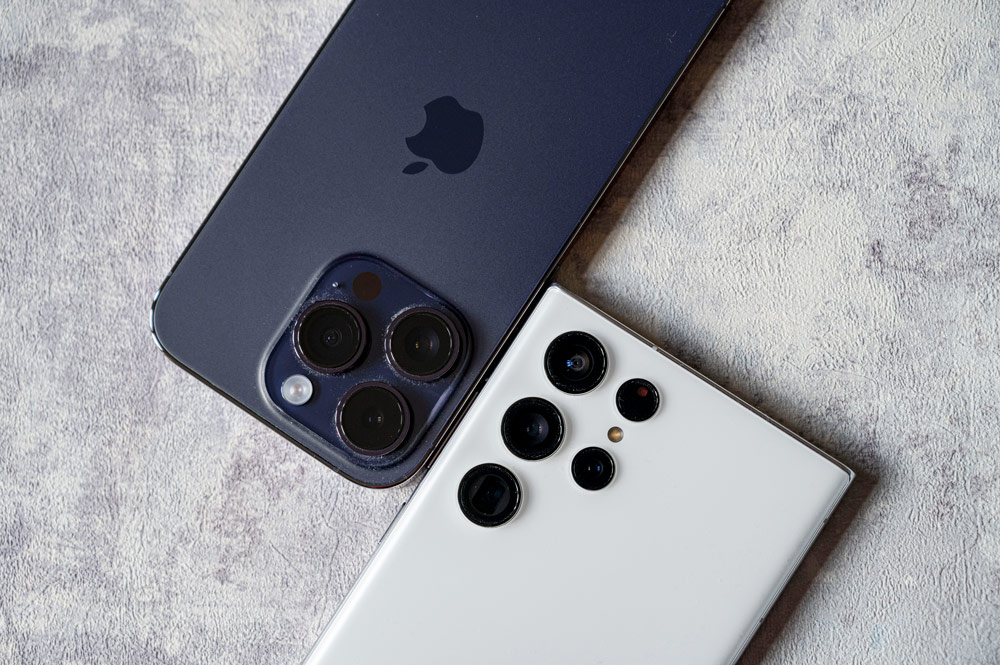Picking the best camera phone is often a tough challenge with more choice than ever, iPhone, or Android? Apple, Google or Samsung? However, I’m here to help you find the best camera phone for you. You want your memories to be captured with the right colours, with the right amount of detail, and not have to worry when taking photos, but worry no more, as I only include the best camera phones on this list.
At AP, we take reviewing smartphones as seriously as we do testing the best cameras – after all, far more images are now shot on smartphones than anything else. I’ve personally reviewed almost every flagship phone in this list, looking at image quality, video quality, editing features, handling, durability, battery life, ease of use, and more, looking at each camera lens and feature in detail. To know more about our testing criteria and what to look for in a smartphone camera, I’ve put together an explainer on how to choose at the bottom of this page.
For most users looking for something for day-to-day photography though, the best smartphone cameras will achieve all that they need, often beating cheap compact cameras. See our smartphone camera photo of the week for inspiration.
- Looking for something cheaper? Check out the best budget and mid-range phones for photography.
So, let’s get stuck into the best camera phones you can buy and don’t forget to download one of the best editing apps for smartphones.
The best camera phones: my quick list
If you want to cut right to it, here’s a quick-reference list of the top rated camera phones me and my team recommend, along with links to get the best prices:
- Best overall camera phone: Samsung Galaxy S25 Ultra: Buy now
- Best overall iPhone: iPhone 17 Pro / Max: Buy now
- Best camera phone (but cheaper): Samsung Galaxy S24 Ultra: Buy now
- Best used iPhone: iPhone 16 Pro / Max: Buy now
- Best flagship for sports and action: OnePlus 13: Buy now
- Best value iPhone camera phone: iPhone 15 Pro: Buy now
- Best AI phone overall: Google Pixel 10 Pro (and Pro XL): Buy now
- Best for advanced photographers: Xiaomi 15 Ultra: Buy now
- Best for close-ups and macro: Vivo X200 Pro
- Best small flagship phone: Samsung Galaxy S25: Buy Now
- Best value flagship: Tecno Camon 40 Premier 5G
Looking for the best deal on premium camera phones? Not only will you find the best camera phones, but you’ll also find some of the best camera phone deals, as our ‘Buy now’ buttons are setup to automatically take you to the best prices, from trusted retailers, plus you’ll also find a list of other retailers below each phone, to find the right deal for you.
Read on to learn more about each of these phones, including key specs and the results of our review team’s testing…
Why you can trust Amateur Photographer
We spend many hours testing every product we recommend, in detail, in a variety of situations and shooting scenarios, and only use experts for our reviews, so you can be sure that you’re getting the best products. Find out more about our expert writers.
Best overall camera phone
Best overall camera phone: Samsung Galaxy S25 Ultra
Amateur Photographer verdict
This is the best all round Android camera phone on the market for both photography and video, with more cameras than most other phones.- 3x high resolution sensors
- 4x lenses (two telephoto)
- Advanced AI features
- Excellent screen
- Minor update from last model
- Very high price
- Macro mode lacking
- S-Pen lacks Bluetooth
Specifications at a glance:
| Rear cameras | 200MP f/1.7 main camera, with OIS, 1/1.3inch, 23mm 50MP f/1.9 ultra-wide-angle camera (0.6x), 13mm 10MP f/2.4 3x telephoto camera, with OIS, 69mm 50MP f/3.4 5x telephoto camera, with OIS, 115mm |
| Selfie camera | 12MP f/2.2 PDAF selfie camera (same on all S25 models) |
| Video | 8K 30fps video, 4K 120/60/30fps |
| Screen | 6.9-inch 3120×1440 pixel AMOLED, 2600 nits peak brightness, Corning Gorilla Armor 2 |
| Battery | 5000mAh battery with wireless charging |
The Samsung Galaxy S25 Ultra is a minor update to the S24 Ultra with an updated design, new ultra-wide camera and updated screen. The main camera has the same headline-grabbing 200MP sensor that uses pixel-binning technology as its predecessor.
The S25 Ultra builds on the AI introduced with the S24 Ultra, with a range of additional features for searching, including inside the photo gallery. There’s also been some improvements to video recording, with the ability to use AI to improve the audio quality as well as Log tools.

Overall, the Samsung Galaxy S25 Ultra is a great performing device, and it produces excellent photos and videos. It’s a big device, which will be to the tastes of some, but perhaps put off others – I’d love Samsung to introduce a smaller Ultra variety, but perhaps it believes the market isn’t there.
The native camera app has a lot going for it, including the AI editing suite which can really help to improve your photographs. Whether you’re shooting stills or making video content, the S25 Ultra is hard to beat.
Also good for: The Samsung Galaxy S25 Ultra is going to provide excellent results in most situations, including landscapes, low-light and night, as well as video, vlogging, YouTube, and more. In fact many YouTubers use this camera for video thanks to the wide range of lenses available.
Read our full Samsung Galaxy S25 Ultra review to see what this smartphone is cable of.
Best overall iPhone camera
Best Apple camera phone: iPhone 17 Pro and Max
Amateur Photographer verdict
Apple’s best iPhone ever made so far – the 17 Pro and Pro Max with new higher resolution 4x telephoto camera, and square 18MP selfie camera- Improved selfie camera
- Triple high-resolution cameras
- Image quality very good overall
- Limited colours
- Weak macro performance
Specifications at a glance:
| Rear cameras | 48MP wide camera, f/1.78 aperture, 24mm equivalent 48MP ultrawide camera, f/2.2 aperture, 13mm equivalent 48MP 4x telephoto camera, f/2.8 aperture, 100mm equivalent |
| Selfie camera | 18MP f/1.9, with AF |
| Video | 4K video up to 120fps |
| Screen | Pro Max: 6.9inch Super Retina XDR OLED screen Pro: 6.3inch Super Retina XDR OLED screen |
| Battery | Pro: 3998mAh battery, Pro Max: 4823mAh battery (more on eSIM versions) |
Whichever iPhone 17 Pro you go for (Pro or Pro Max), you’re getting the same updated camera system on both models, the only differences being the phone size (including the screen and battery). This year we’ve got an update to the telephoto camera, which now has a higher resolution 48MP sensor, a 4x telephoto lens, and offers an 8x “optical quality” digital crop/zoom option, that can give nice results. There’s also an updated 18MP selfie camera with a square sensor making it easier to shoot any way you hold the phone.
I reviewed the phone, and found the overall package extremely good in terms of camera features, but I’m still waiting for Apple to improve the macro performance, which has been overtaken by Android phones which now tend to use the telephoto camera (with a periscope design) to give more pleasing macro images.
These updates may be enough to persuade people to upgrade from the 15 and 16 series, but there have been questions raised about the durability of the new aluminium design.

The iPhone 17 Pro / Max offer the best iPhone cameras, and if you prefer the Apple way of doing things then this is a great choice. The main choice now, will be whether you want the larger phone, or the more compact phone.
Read our full iPhone 17 Pro review.
2nd best Android camera phone
Best Samsung camera phone (but cheaper): Samsung Galaxy S24 Ultra
Amateur Photographer verdict
It was the best all round Android camera phone on the market for both photography and video until the new S25 Ultra came out.- Improved image quality (slightly)
- Massively improved screen – anti-reflective coating
- Added AI features
- Reflection removal particularly useful
- Macro mode lags behind others
- Shutter lag really hurts for fast moving subjects
- 45W charging is looking slow
Specifications at a glance:
| Rear cameras | 200MP f/1.7 main camera, with OIS, 1/1.3inch, 23mm 12MP f/2.2 ultra-wide-angle camera (0.6x), 13mm 10MP f/2.4 3x telephoto camera, with OIS, 69mm 50MP f/3.4 5x telephoto camera, with OIS, 115mm |
| Selfie camera | 12MP f/2.2 PDAF selfie camera (same on all S25 models) |
| Video | 8K 30fps video, 4K 120/60/30fps |
| Screen | 6.8inch screen, 1-120Hz, 2600nits, with Corning Gorilla Glass Armor |
| Battery | 5000mAh battery with wireless charging |
The Samsung Galaxy S24 Ultra succeeds S23 Ultra as Samsung’s flagship model, and is Samsung’s top dog in terms of photography, until that is, the S25 Ultra came out (see above). Its main camera has the same headline-grabbing 200MP sensor that uses pixel-binning technology as its predecessor. However, the telephoto camera has been upgraded to a new 50MP 5x telephoto zoom from the previous 10MP 10x telephoto seen on the S22/S23 Ultra.
A new generation of AI technology is introduced with the S24 series, utilised during image capture and said to improve night photography, noise performance, zoom quality and HDR imaging among others. AI is also relevant in the new on-device and cloud-based editing features like its new Reflection removal tool. Speaking of reflection removal, which is really useful, the S24 Ultra also has one of the best screens on any phone, thanks to the anti-reflective coating on the screen.

The S24 Ultra records video up to 8K 30fps, and with AI can also be used to create slow-motion videos by generating interim frames in a video, letting you create slow-motion videos after you record them.
Following our full review, I noted the incremental improvements to the cameras and features in Samsung smartphones, but there were some areas where I’d like to see some additional improvements, namely in macro. I did conclude, though, that the Samsung Galaxy S24 Ultra is one of the best camera phones currently available in the mainstream, and I stick by that. Now that the Samsung Galaxy S25 Ultra has been announced, look out for S24 Ultra deals.
Read our full Samsung Galaxy S24 Ultra review to see what this smartphone is cable of.
Best used iPhone camera
Best used Apple camera phone: iPhone 16 Pro and Max
Amateur Photographer verdict
Apple’s best phone for 2025 is the 16 Pro and Pro Max adding some additional camera updates, rather than anything ground-breaking- Pro Max benefits from larger screen
- New camera control button
- Image quality very good overall
- Low resolution telephoto camera
- Low resolution selfie camera
- Weak macro performance
Specifications at a glance:
| Rear cameras | 48MP wide camera, f/1.78 aperture, 24mm equivalent 48MP ultrawide camera, f/2.2 aperture, 13mm equivalent 12MP 5x telephoto camera, f/2.8 aperture, 120mm equivalent |
| Selfie camera | 12MP f/1.9, with AF |
| Video | 4K up to 120fps |
| Screen | Pro Max: 6.9inch Super Retina XDR OLED screen Pro: 6.3inch Super Retina XDR OLED screen |
| Battery | Pro: 3582mAh battery, Pro Max: 4685mAh battery |
Whether you go for the iPhone 16 Pro or the 16 Pro Max, you’re getting the same camera system, the only differences being the phone size (including the screen and battery). This iPhone update sees the ultra-wide-angle camera updated, as well as a new photo control button on the side that helps give quicker access to photo settings (such as zoom, etc). Hardly as ground-breaking as Apple would make out, but a welcome addition.
I reviewed the phone, and found the new controls useful, but would have liked to see Apple improve the macro performance, which has been overtaken by Android phones, and I’d also like Apple to improve the selfie camera, which struggles in low-light.
These updates may not be enough to persuade people to upgrade from the 15 Pro Max, but if you want a very good iPhone, and don’t want to break the bank, then the 16 Pro / Pro Max is a good choice, especially as prices for used or refurbished are much lower than new models.

These are also the best iPhones available for zoom, thanks to the 5x telephoto camera.
Read our full iPhone 16 Pro review, as well as our 16 Pro Max review. JW
Best for sports and action
Best flagship for sports and action: OnePlus 13
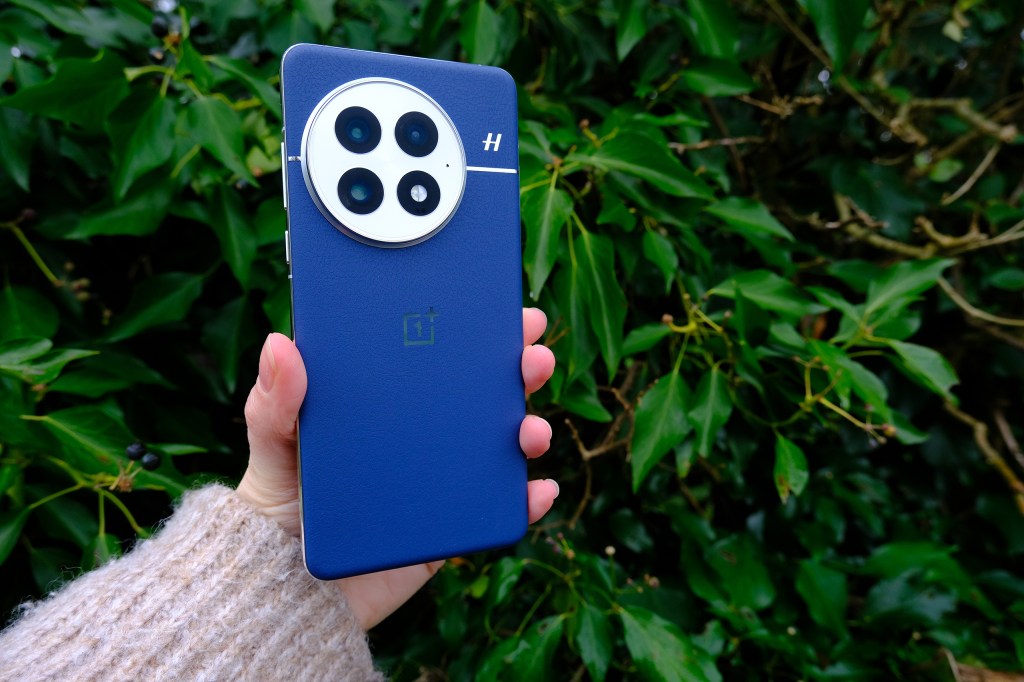
Amateur Photographer verdict
This is a great all-round phone from OnePlus with fantastic cameras, that deliver excellent image quality in a variety of conditions.- Great value, all-round flagship
- Excellent battery life
- Hasselblad partnership on cameras
- Premium build quality
- Selfie camera still fixed focus only
- No 4K 120fps video
Specifications at a glance:
| Rear cameras | 50MP main camera, f/1.6, OIS, 1/1.4″ sensor 50MP 120° ultra-wide-angle camera, f/2.05, 1/2.75 sensor 50MP 3X Triprism Telephoto camera, f/2.6, OIS, 73mm focal length, 1/1.95″ sensor |
| Selfie camera | 32MP front camera, f/2.45, fixed focus, 1/2.74″ sensor |
| Video | 4K 60fps on all cameras including front, 8K 30fps video recording available to rear cameras |
| Screen | 6.82inch screen, 1-120Hz dynamic, 1600/4500 nits, Ceramic Guard glass |
| Battery | Silicon NanoStack 6,000mAh battery |
This flagship phone from OnePlus features an impressive array of specs that make it a worthy contender for the likes of Apple, Samsung and Google. And it does this at a significantly lower starting price of $899 / £899. It has everything you would expect from a high-end phone with AI features, a generous 6.82” screen, sturdy battery life and of course a capable triple-lens rear camera setup.
There is a 23mm wide angle, a 15mm ultra-wide angle and a 73mm triprism lens that provides approximately 3x optical zoom. All three lenses have a 50MP sensor, however, the main wide angle lens uses a larger, 1/1.4inch sensor whereas the others are smaller. Thanks to the firm’s continuing partnership with Hasselblad there’s a 1x, 2x, and 3x Portrait mode that emulates the look from Hasselblad camera lenses.
You can record up to 8K resolution at 30fps but keep in mind the space these videos will occupy, there’s also a 4K 60fps option and of course slow-mo at 1080p 240fps. The OnePlus 13 currently holds the position of highest peak brightness smartphone screen on the market with an incredible 4500 nits, so you can not just record high-quality video but enjoy watching even in very bright sunlight.
Thanks to a dual exposure algorithm that merges a regular and a long exposure shot, photos are sharp with very minimal motion blur, this makes the OnePlus13 ideal for shooting sports, action and fast moving subjects. Combine this with the Burst function in the dedicated Action mode and you won’t miss a shot.
Read our full review of the OnePlus 13
Best value iPhone
Best Apple camera phone: iPhone 15 Pro
Amateur Photographer verdict
Apple’s best device so far, until the 16 came out, but most of it’s improvements come down to usability rather than a big leap in image quality- Improved shooting modes for photo and video
- Tough and well-built
- USB-C port
- Fairly minor upgrade over iPhone 14 Pro
Specifications at a glance:
| Rear cameras | 48MP wide camera, f/1.78 aperture, 24mm equivalent 12MP ultrawide camera, f/2.2 aperture, 13mm equivalent 12MP 3x telephoto camera, f/2.8 aperture, 77mm equivalent |
| Selfie camera | 12MP f/1.9, with AF |
| Video | 4K up to 120fps |
| Screen | 6.1inch Super Retina XDR OLED screen |
| Battery | Pro: 3274mAh battery |
While not the biggest iPhone on the block – that being the iPhone 16 Pro Max – the iPhone 15 Pro offers a balanced set of features that make it realistically the best option for most users. It’s no great jump from the previous year’s iPhone 14 Pro, but the iPhone 15 Pro makes several clever usability upgrades that improve the experience for the smartphone photographer and videographer. Now that the 16 Pro is out (see above), this phone should be available for less, while stocks last.
For instance, portrait mode can now kick in automatically when the facial recognition system detects a human subject (or a pet, for that matter). What’s more, an image can also be turned into a portrait post-capture. Video shooters get new Log profiles, which allows for much more flexibility when it comes to colour-grading footage. And Apple has finally relented on the port and given us the widely used USB-C connection, rather than its proprietary Lightning port. At last!
In our full review, we concluded that the improvements to the iPhone 15 Pro over the iPhone 14 Pro are relatively marginal, and that it was another excellent device. Neither this model nor its bigger Pro Max cousin has quite done enough to dethrone the Samsung Galaxy S24 Ultra, the current king of the hill when it comes to smartphone imaging.
Read our full iPhone 15 Pro review, as well as our comparison piece on the iPhone 15 Pro vs iPhone 14 Pro to learn more about this excellent camera phone. Plus read our comparison of the iPhone 15 Pro Max vs Samsung Galaxy S24 Ultra.
Best AI phone
Best AI phone for photography: Google Pixel 10 Pro (and XL)
Amateur Photographer verdict
For photographers, the Google Pixel 10 Pro delivers exceptional photos, in the majority of shooting scenarios, plus has AI enhanced zoom. However, if you’re a macro fan, then others are better.- Consistently good photos
- Panorama mode works well
- AI features like Add-me
- Additional 2x and 10x zoom options – plus AI enhanced zoom
- Macro performance is lacking
- 4K 60fps is max video quality (without Cloud upscaling)
- 128GB storage is poor for a flagship
Specifications at a glance:
| Rear cameras | 50MP main camera, f/1.68, OIS 48MP ultra-wide, f/1.7, with macro AF 48MP telephoto, f/2.8, 5x telephoto, OIS |
| Selfie camera | 42MP f/2.2 selfie camera with AF |
| Video | 4K video recording, up to 60fps |
| Screen | 6.3inch screen, 1-120hz, 3300nits (peak), Gorilla Glass Victus 2 |
| Battery | 4870mAh battery with wireless charging |
The Google Pixel series has long been a choice for those who put the photography features before everything else. The Google Pixel 10 Pro continues that tradition with improvements being made to the cameras, as well as shooting features, with enhanced zoom as well, thanks to additional AI improvements.
There’s a great triple camera setup on the back with an ultra-wide camera with AF, a main camera with optical image stabilisation (OIS), and a 5x telephoto camera, also with OIS. The phone also provides a 2x zoom, and a 10x zoom, that uses Super Resolution Zoom to provide ‘optical quality’ zoom, and in my testing, I found this actually worked really well! Beyond 10x zoom the camera system will use AI to add additional detail to images, giving you images that look better than the blurry mess of digital zoom.
There’s also a great selfie-camera, with 42MP, which uses pixel-binning to give 10.5MP images. There’s auto-focus, and the selfie camera is wider than the 8 series, meaning you can get more in the shot. The ultra-wide-angle camera has a bright f/1.7 aperture, compared to the f/2.0 aperture on the Pixel 8 Pro.

As a Google phone, the HDR shooting has been updated, and is now more impressive, with the phone coping with high dynamic range situations incredibly well, whether that’s outdoors, or in low-light conditions. There are further improvements made to the AI features on offer as well, with Add-me being a particularly useful feature for people who want to be in the shot when taking group photos.
Unfortunately the phone doesn’t record 8K video on the phone directly, maxing out at 4K 60fps, so if high-resolution (8K) video is what you’re looking for, other phones do this better. There are also others that also offer 120fps 4K video. Other negatives, include the macro performance of the phone, which is lacklustre. Using the ultra-wide-angle camera and cropping into the shot gives an image lacking in detail.
Google give you a choice of size, with the larger 10 Pro XL, and smaller Google Pixel 10 Pro, both featuring the same impressive camera system, so you can choose which size is best for you.
Best for: AI features that are easy to use, plus night and astrophotography. Google phones have an impressive night mode, as well as support for astrophotography. The AI editing is particularly impressive as well, and Google have hit the ground running with this.
Read our full Google Pixel 10 Pro review to get all the details. JW.
Best for photographers
Best for advanced photographers: Xiaomi 15 Ultra
Amateur Photographer verdict
One of the best performing smart phones on the market with an impressive array of cameras that deliver excellent image quality, however this comes at a flagship price- 1inch main sensor
- 3x 50MP cameras, plus 200MP
- Raw shooting and pro mode
- Photography kit available
- High price
- Selfie camera doesn’t have AF
- Not available in every market
Specifications at a glance:
| Rear cameras | 50MP main camera with 1inch sensor and f/1.63 aperture 50MP f/2.2 ultra-wide (14mm equiv) 50MP f/1.8 3x telephoto (70mm equiv) 200MP f/2.6 4.3x telephoto (100mm equiv) |
| Selfie camera | 32MP f/2.0 camera without AF |
| Video | 8K 30fps / 4K 120fps video |
| Screen | 6.73-inch LTPO AMOLED, 3200 x 1440 pixels, 120Hz, 3200nits (peak) |
| Battery | 5410mAh battery (international) |
There’s an awful lot to like about the Xiaomi 15 Ultra, starting with the Leica branded camera system. It’s packed with a great range of features, including a one-inch main sensor, putting it ahead of most rivals. You can shoot using all three lenses in 50MP mode, and the telephoto camera has been upgraded to a 200MP unit for improved telephoto zoom. Video performs pretty well and it has a slew of options including slow motion, night video, video pro mode and a tracking mode.
While the Xiaomi 15 Ultra is not cheap, it fares well when compared to competing flagship models. It is also likely to drop in price more quickly – on the second-hand market too – compared with the likes of the bigger name (at least in certain markets) Samsung and Apple phones. Keep an eye out for an emerging gap in prices.
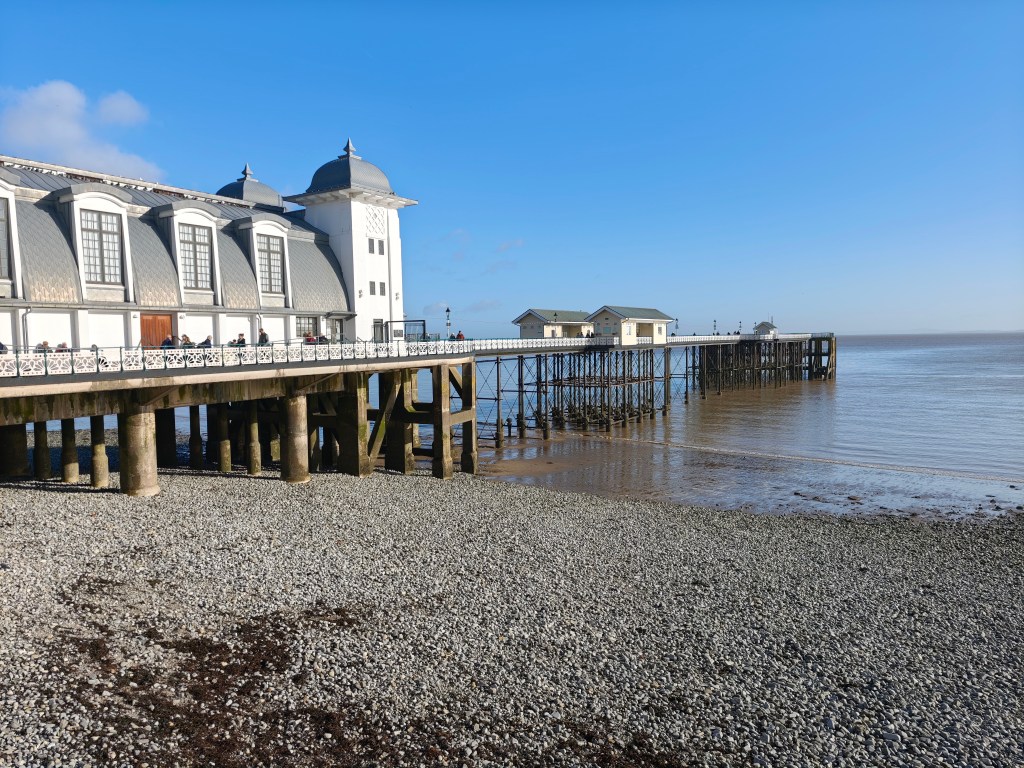
Our review found it to be an extremely capable smartphone which produces excellent results in a wide variety of different shooting scenarios, with some impressive close-up macro performance as well. In our opinion, it even gives the Samsung Galaxy S25 Ultra a run for it’s money, which is saying a lot! The only thing lacking is in the selfie-camera, which doesn’t feature auto-focus.
Read our full Xiaomi 15 Ultra review.
Best for close-ups
Best for close-up photography: Vivo X200 Pro
Amateur Photographer verdict
The X200 Pro has an exceptional set of rear cameras. If the Vivo X200 Pro had a selfie camera with auto-focus, this would be the perfect camera phone- Amazing telephoto close-up performance
- Impressive main camera
- Array of Zeiss shooting features
- Great battery life
- Limited availability, not available worldwide
- Selfie camera is fixed focus
- Colours can be a bit over the top
Specifications at a glance:
| Rear cameras | 50MP f/1.6 main camera with 1/1.28inch sensor, OIS, 23mm, PDAF 50MP f/2.0 ultra-wide-angle camera, 15mm, AF 200MP f/2.7 3.7x telephoto camera, with close focus, 85mm, OIS, AF |
| Selfie camera | 32MP f/2.0 selfie camera, fixed focus |
| Video | 8K 30fps, 4K 120fps video |
| Screen | 6.78inch AMOLED screen with 4500nits |
| Battery | 6000mAh battery |
This flagship smartphone by Vivo comes with an impressive triple set of cameras created in collaboration with Zeiss. All cameras are equipped with high resolution sensors with auto-focus and OIS (optical image stabilisation), and the 200MP 3.7x periscope camera gives macro features. These specs make the Vivo X200 Pro a formidable competition for the well-known flagships.
The main 23mm f/1.75 camera features a 50MP 1/1.28inch sensor, which is larger than many other phones. It delivers consistently impressive results with plenty of detail, excellent colour reproduction, and reliable exposure. Moreover, the dynamic range is great with HDR automatically turning on when needed.
The Zeiss APO floating telephoto camera is a periscope design, and it gives you amazing looking close-up photos, even in poor lighting, with plenty of detail. It is also backed by a 200MP sensor, helping capture even more detail. Finally, the last ultra-wide-angle 15mm, f/2 camera provides nice results, with good colour and exposure, as well as good levels of detail. The camera app gives you quick access to 0.6x, 1x, 2x, 3.7x and 10x making it feel like you’ve got way more cameras than there actually are.

In use, the Vivo X200 Pro proved a highly capable camera phone that more than justified its flagship price tag. The larger sensor on the main camera means the high-ISO performance is excellent, making the phone immensely capable in low light. We noted in our review that the selfie camera is a little weak and lacks autofocus. It’s also worth noting that this phone is currently only available in some markets. If you can get hold of one though, it’s an amazing performer with highly capable cameras. Hopefully next years update will be more widely available.
Best for: Macros and close-up, with great low-light performance. This is the phone I use for product photography, with the telephoto lens producing great results.
Read our full Vivo X200 Pro review.
Best small camera phone
Best Small Samsung flagship: Samsung Galaxy S25/S25+
Amateur Photographer verdict
If you prefer a cheaper and slightly smaller phone, but don’t want to compromise too much on specs the S25 or 25+ could be a great choice. A solid all rounder, even without a dedicated macro mode.- High resolution main camera
- AF Selfie camera
- 8K video
- No macro mode
- Lower resolution ultrawide and telephoto camera
- Only 128GB on the base S25
Samsung Galaxy S25 (4000mAh battery, 6.2inch) / S25+ (4900mAh, 6.7inch):
If your budget is a bit tighter but you still want to get most of the S25 Ultra specs, the S25 or the S25+ is an ideal choice. The biggest differences from the S25 Ultra are the lack of headline grabbing 200MP super-high resolution main sensor, no dedicated macro mode, and only three lenses instead of four. But in reality both are very capable and well performing camera phones.
Both S25 and S25+ feature an identical camera set-up, with a 12MP ultra-wide camera, a 50MP main wide camera, 10MP 3x telephoto, and 12MP front selfie camera (with AF), and up to 8K video recording from the main camera. For video or vlogging, the S25/S25+ offer a great setup, as the selfie camera can also be used for 4K video recording.
The only difference between these two flagships are their size, price, and battery life. Both have a smaller body than the S24 Ultra, however the Samsung Galaxy S25+ measures 158.4 x 75.8 x 7.3mm and features a 6.7inch Dynamic AMOLED screen which is not far off from the S25 Ultra’s 6.9inch size. If you want to go for a smaller version opt for the Samsung Galaxy S25 with 6.2inch screen, it sits more comfortably in the hand, however its smaller size means smaller battery too.
Best value flagship
Best value flagship: Tecno Camon 40 Premier 5G
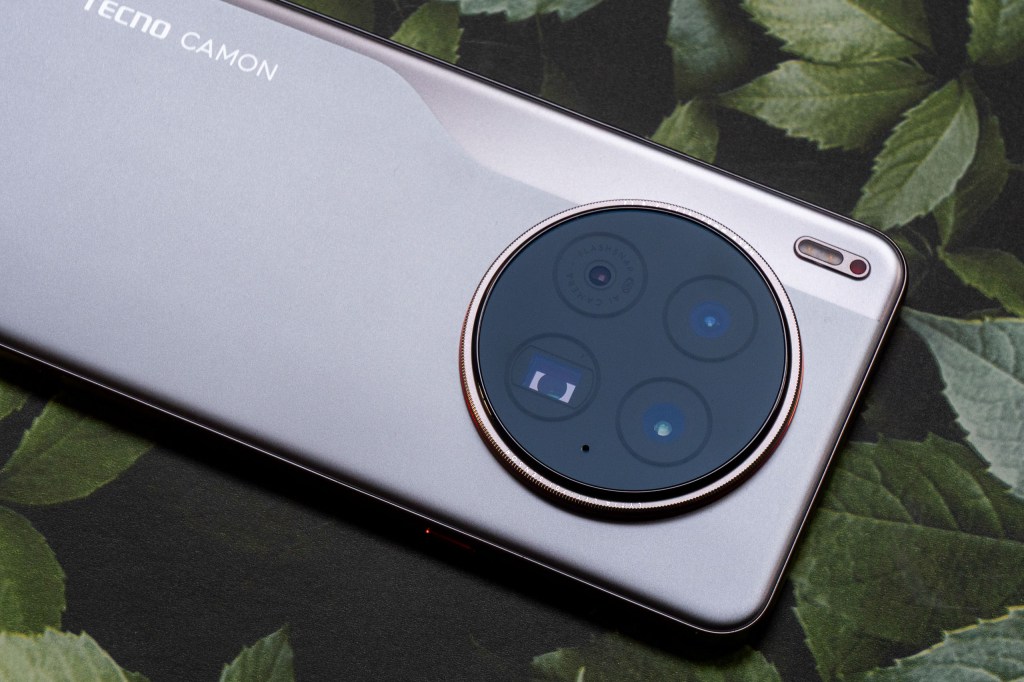
Amateur Photographer verdict
If the Camon 40 Premier is available near you, then it’s well worth shortlisting, as it offers a lot of camera for the price- Price
- 3x 50MP main cameras
- 50MP selfie camera with AF
- Not available in all markets (like the US or UK)
- Portrait outlines could be improved
Specifications at a glance:
| Rear cameras | 50MP f/1.8, 23mm (1x) equivalent camera, 1/1.56” sensor, PDAF, OIS 50MP f/2.0, 14mm (ultrawide) equivalent camera, 1/2.76” sensor, PDAF 50MP f/2.4, 70mm (periscope 3x telephoto) equivalent camera, 1/2.76” sensor, PDAF |
| Selfie camera | 50MP f/2.5, 24mm equivalent selfie camera, PDAF |
| Video | 4K video at 60fps |
| Screen | 6.67inch screen |
| Battery | 5100mAh battery with fast charging |
The Tecno Camon series of phones is Tecno’s flagship range of smartphones designed for photography. The Tecno Camon 40 Premier 5G is the top of the range model (the Camon 40 Pro sits slightly beneath it), and offers a premium triple camera setup for roughly half the price of flagships from the likes of Samsung, Apple, and Google. However, it’s only available in certain markets, so if you find yourself in that market, count yourself one of the lucky ones. It’s priced so competitively it’s likely to fit both in this list of premium camera phones, as well as our list of the best budget phones.
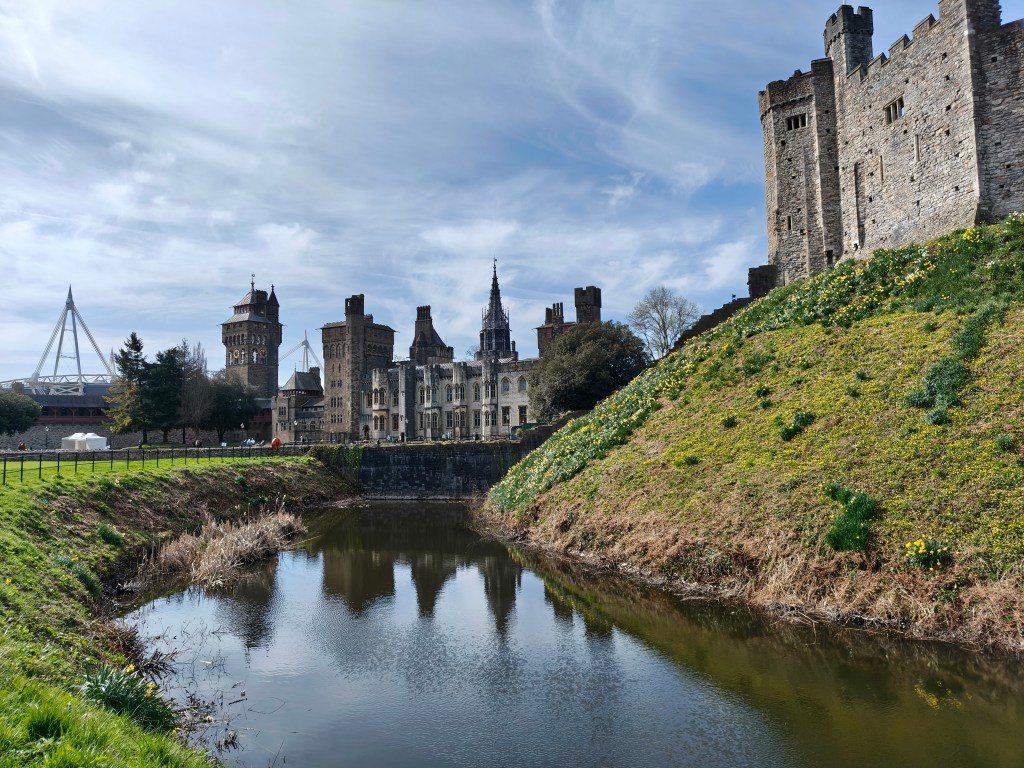
All camera units on this feature a 50MP sensor, and on the back you get cameras that offer ultra-wide angle (14mm equivalent), wide-angle (23mm equivalent), and 3x telephoto (70mm equivalent), and on the front you’ll find a 50MP f/2.4 camera with auto-focus! The phone can also record 4K video at 60fps, has a generous 5100mAh battery, with fast charging, but unfortunately wireless charging isn’t included.
Read our full Tecno Camon 40 Premier review
Frequently asked questions (FAQ)
How to choose the best camera phone for the best photos

Sensors and image quality
Comparing the headline specs of camera phones can be a useful way of getting a sense of how they perform, and which ones might be better than others. Digital photography enthusiasts may gravitate towards comparing camera resolution (megapixels or MP for short), however this often doesn’t tell the whole story.
Does megapixel count matter on a camera phone?
In short, no, not really. Most smartphones will use a higher resolution sensor, whether that’s a 50MP, 64MP, 108MP or 200MP sensor, and still give you a 12 or 16MP image. Nobody wants to get 108MP or 200MP photos emailed or shared to them anyway, so no, megapixel count doesn’t really matter on a camera phone, despite what the marketing might claim. There are some small benefits to higher resolution sensors, in the form of cropping and lossless zoom, but beyond that, there are also disadvantages.
Smartphone cameras generally use very small sensors, due to their physical size and shape, and this can mean a lot of image noise in high-resolution shooting, however, some use larger 1inch sensors. Modern phones make up for this by taking multiple shots and merging them together into one photo, allowing for lower noise, and greater dynamic range, so a small sensor isn’t as much of a disadvantage as it once was.
When we talk about a smartphone’s main cameras (i.e. the rear cameras), we’re really talking about more than one, as modern smartphones use a camera array made up of multiple lens modules. This is what allows smartphones to shoot at different perspectives; generally there will be a standard wide lens, an ultra-wide-angle lens, and then sometimes a telephoto lens or a macro-lens for close-ups.
The different lenses use their own sensors, and as such will tend to have different megapixel counts. Some of the latest smartphones even use quad camera arrays with four modules, while other manufacturers are experimenting with optical zoom lenses, though this tech is in its early days, with mixed results.
Battery life
You should also consider battery life, as some phones last the day while others do not. Most flagship phones have a battery with 5000mAh which should give a good amount of longevity, however, smaller phones often have smaller batteries, so it’s something to be aware of.
Video
The top video resolution will be of interest, almost all flagship phones will offer 4K video, but do they also offer it from the selfie camera? The best phones for video also offer 8K video, or 4K video at high frame rates of 120fps. You’ll also want advanced lens options and good quality audio recording. If you’re shooting video, battery size is particularly important, as it tends to eat away at a phone’s battery faster.
Check out the best smartphones for video if that’s your priority, but otherwise, continue reading.
Is iOS or Android better for photography?
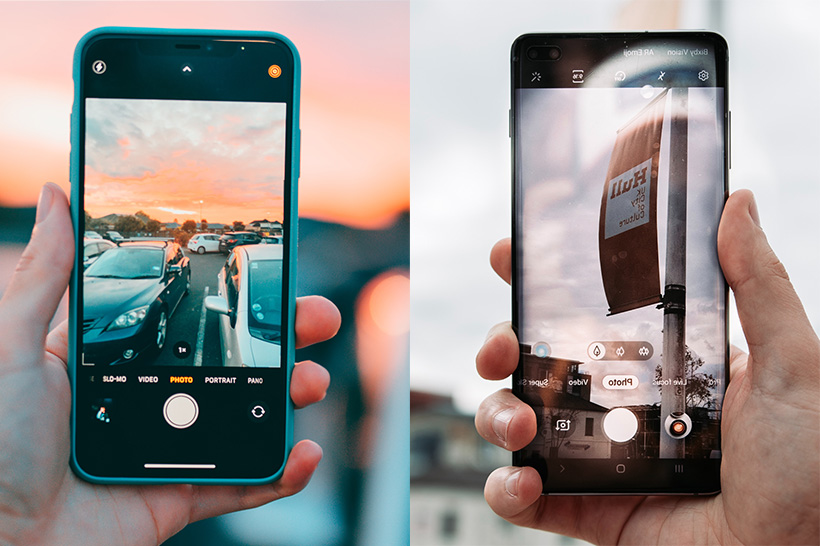
One big thing to think about is whether you want to use a phone that runs iOS vs Android as its operating system. Both systems have their own advantages and disadvantages when it comes to smartphone photography, as well as general use as a smartphone.
If you already use a lot of Apple products like MacBooks then an iPhone will integrate better into your system. However, Android phones offer a lot more choice and flexibility with third-party apps. These days, Android phones from market leaders like Google and Samsung have some of the best cameras in the business.
When choosing a phone, whether Android or iOS, it’s worth checking how many years of updates you’ll get, as some phones give much longer than others, meaning better value for money for you.
You can check out our guide to iPhone vs Android: which is better for photography for a detailed comparison.
Is there a DSLR-quality camera phone?
With smartphone camera technology continually advancing, you may be wondering whether they have equalled or even surpassed the quality of traditional interchangeable-lens cameras like DSLRs or mirrorless models. However, for the time being, the answer is no, and this is largely to do with physical hardware limitations.
A premium digital camera can pack in a physically larger imaging sensor, which allows it to produce images with higher quality, and lower noise without multi-shot processing. In bright sunny conditions, the difference may not be as noticeable, but in low-light conditions, this is where you’re more likely to notice it. The majority of mirrorless and DSLR cameras also provide more resolution, with 24MP, 40MP, 47MP and 61MP (etc) sensors giving the full-resolution, without pixel-binning.
Cameras also have the advantage of interchangeable lenses – being able to put on an 85mm f/1.4 lens is always going to give you better results than a smartphone’s portrait mode. Granted, if you were to look at the two images side by side on a small phone screen the differences might not be so obvious. But the moment you try to view the image on a larger display, or print it, the difference in quality will be obvious.
The acceleration of progress in smartphone cameras has certainly raised the question of whether they can replicate the quality of digital cameras and DSLRs. Ultimately, with their interchangeable lenses, larger sensors, and raw imaging capability, the answer is: not yet. Some genres and shooting situations, such as portrait photography and macro photography are certainly better served by a camera than a smartphone, but phones are catching up quickly.
And, smartphones have their advantages, of course, they’re convenient, they’re always online, and they’re the camera you always have on you. If you’re still not sure which is right for you, then have a look at our guide to Smartphone vs Digital Camera: Which is better?
Why isn’t the Sony Xperia on the list?
We reviewed the flagship Sony Xperia 1 VI phone, and whilst we have seen a number of improvements in the phone from Sony, we found that the telephoto zoom camera on the phone gave disappointing images, and the portrait and low-light images couldn’t match other flagship phones. There are some unique features on the phone, such as a manual focus close-up macro mode, and a lot of manual controls, but for most people, this could end up being a frustrating shooting experience. However, if you do need a phone with a headphone jack and MicroSD slot, this is one of very few flagship phones with these features. Check out our full Sony Xperia 1 VI review to see if it’s right for you.
How we test smartphones for photography
We have reviewed and tested every single phone on this list, thoroughly, using them extensively for at least 2 weeks (often longer), so you can trust our recommendations when deciding which phone to buy.
We review smartphones from the perspective of choosing a smartphone for its photography and camera performance, so we test every phone by looking at what it offers in terms of the cameras and what features are included for photography and video, and how it performs in real world use in a variety of different shooting situations. We look at video quality for both picture quality, smoothness of zoom, as well as the audio quality on offer.
We test each camera on the phone, whether that’s the ultra-wide angle, the main camera, telephoto camera(s), and selfie camera, as well as the additional “lenses” (the extra zoom levels) and zoom modes on offer (whether that’s real or digital/AI generated), plus any additional modes these lenses offer, whether that’s macro or telephoto macro. These premium phones should be putting in a stellar performance with every camera on the phone, including the selfie camera.
We use the phones for photography in a range of lighting conditions, including low-light, where camera phones can struggle, and this will highlight any weaknesses from smaller sensors. We shoot in bright conditions, where cameras can struggle with bright and dark areas, and this tested the dynamic range of the cameras as well as how well the phone handles high-dynamic-range (HDR) processing.
We also look at specialist shooting modes on offer, including the portrait modes on offer, looking at how well it deals with the subjects skin tones, background blur, and areas of detail like around the hair. We also look at AI features, for example, when shooting photos, and when it comes to editing, what AI editing tools are on offer and how do they perform.
In addition to all of this, we look at how good the overall phone is, in terms of battery life so you can keep shooting throughout the day, the screen quality and brightness (testing this in bright outdoor light and checking visibility), and overall build quality.
Recent updates
- October 2025 Update 2: iPhone 14 Pro removed as best value used iPhone, see our guide to the best iPhones for photography for all price options. Google Pixel 8 Pro removed as only available to buy refurbished and second-hand. Intro text clarified, and Google Pixel 10 Pro updated to Best AI phone thanks to all the AI features that make it easier to get great photos. Samsung Galaxy S23 Ultra removed as newer phones can offer the same level of zoom (through clever hybrid zoom), and S23 Ultra is getting old, and therefore will get less updates compared to newer models. How we test section expanded to explain in more detail how we test the phones.
- October 2025 Update: iPhone 17 Pro review now live on site, and added as the best iPhone camera ever made. Updated low-light photo taken with the Google Pixel 10 Pro.
Now you know the best camera phones for photography, check out our guide to the best camera phone accessories and best camera phone tripods and mounts.
Related reading:
- Best smartphones for macro
- Best smartphones for street photography
- Best smartphones for portrait photography
- Best smartphones for low light

